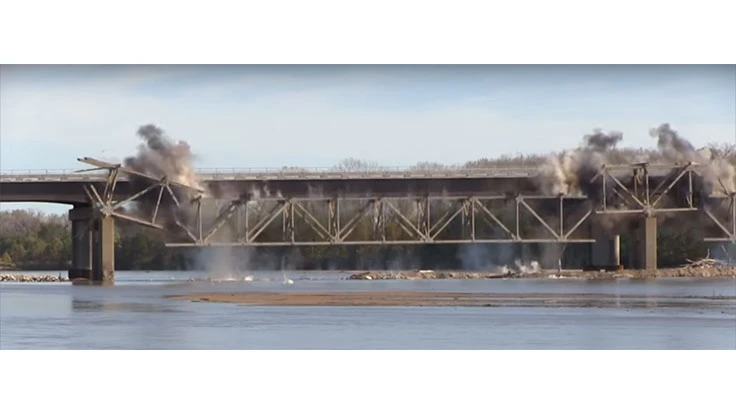
The Willard Bridge in Shawnee County, Kansas, was imploded Oct. 25, finishing off a more than $18 million project replacing the old structure, a report by the Topeka Capital-Journal says.
Notices were sent to residents within the 1,500-foot implosion zone before the demolition, the report says. County Commissioner Shelly Buhler, County Public Works Director Tom Vlach and a small construction crew were the only ones present when the implosion occurred.
Crews used 25 to 30 pounds of RDX explosion, developed by NASA to separate rocket boosters, to tear down the old bridge. A crew from A.W. Cohron and Son will remove the metal and cut the concrete supporters Oct. 26.
Willard Bridge was built in 1955 and was rehabbed in 1983. The report says age caused the it to fail. It went through a series of weight limit reductions in 2015, making its maximum weight 9 tons. The report says the bridge could only hold passenger cars, but was once frequently used by residents carrying farm equipment and school buses between Willard and Rossville.
The report says the new bridge is expected to last 100 years and will be built on a concrete deck rather than a steel grate, have wider shoulders and a bike and walking path on the east side. The project cost $7 million less than expected and was completed in August, ahead of its December deadline.
Watch a video of the implosion, provided by the Topeka Capital-Journal, below:
Notices were sent to residents within the 1,500-foot implosion zone before the demolition, the report says. County Commissioner Shelly Buhler, County Public Works Director Tom Vlach and a small construction crew were the only ones present when the implosion occurred.
Crews used 25 to 30 pounds of RDX explosion, developed by NASA to separate rocket boosters, to tear down the old bridge. A crew from A.W. Cohron and Son will remove the metal and cut the concrete supporters Oct. 26.
Willard Bridge was built in 1955 and was rehabbed in 1983. The report says age caused the it to fail. It went through a series of weight limit reductions in 2015, making its maximum weight 9 tons. The report says the bridge could only hold passenger cars, but was once frequently used by residents carrying farm equipment and school buses between Willard and Rossville.
The report says the new bridge is expected to last 100 years and will be built on a concrete deck rather than a steel grate, have wider shoulders and a bike and walking path on the east side. The project cost $7 million less than expected and was completed in August, ahead of its December deadline.
Watch a video of the implosion, provided by the Topeka Capital-Journal, below:
Sponsored Content
Reach Higher. Demolish Smarter.
Take your demolition work to new heights with the Komatsu PC490HRD-11. Engineered for precision and control, this high reach excavator helps safely dismantle structures while enhancing operator confidence and jobsite productivity. A Montabert grapple’s robust design and secure handling make it ideal for selective demolition.
Get curated news on YOUR industry.
Enter your email to receive our newsletters.Loading...
Latest from Construction & Demolition Recycling
- Block Island Recycling Management Inc. aims to promote environmental stewardship
- SDI’s earnings rise quarter on quarter
- Complaints prompt relocation of concrete recycling plant
- Ferrous traders see price stability continuing
- LRS diverts 330,000 tons of recyclable material in 2024
- Elevating industry standards
- Takeuchi adds dealer locations in central US
- Tariffs target steel exporters Brazil, Canada and South Korea








